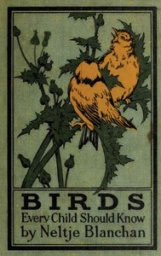

Birds Every Child Should Know (1907)
by Neltje Blanchan


What tempts him so far north? You know that certain flowers depend upon certain insect friends to carry their pollen from blossom to blossom that they may set fertile seed; but did you know that certain other flowers depend upon the hummingbird? Only his tongue, that may be run out beyond his long, slender bill and turned around curves, could reach the drops of nectar in the tips of the wild columbine's five inverted horns of plenty. The Monarda or bee-balm, too, hides a sweet sip in each of its red tubes for his special benefit. So does the coral honeysuckle. There are a few other flowers that cater to him, especially, by wearing his favourite colour, by hiding nectar so deep that only his long tongue can drain it, and by opening in orderly succession so that he shall fare well throughout the summer, not have a feast one month and a famine the next. In addition to these flowers in Nature's garden that minister to his needs, many that have been brought from the ends of the earth to our garden plots please him no less. The canna, nasturtium, phlox, trumpet-flower, salvia, and a host of others, delight his eye and his palate. Don't you think it is worth while to plant his favourites in your garden if only for the joy of seeing him about? He is wonderfully neighbourly, coming to the flower-beds or window-boxes with undaunted familiarity in the presence of the family. A hummingbird that lived in my garden sipped from a sprig of honeysuckle that I held in my hand. But the bird is not always so amiable by any means. A fierce duelist, he will lunge his rapier-like bill at another hummer with deadly thrusts. A battle of the midgets in mid-air is a sorry sight. You may know a male by the brilliant metallic-red feathers on his throat. His mate lacks these, but her brilliancy has another outlet, for she is one of the most expert nest-builders in the world. An exquisitely dainty little cup of plant down, felted into a compact cradle and stuccoed with bits of lichen bound on by spider-web, can scarcely be told from a knot on the limb to which it is fastened. Two eggs, not larger than beans, in time give place to two downy hummers about the size of honey-bees. Perhaps you have seen pigeons pump food down the throats of their squabs? In this same way are baby hummingbirds fed. After about three weeks in the nest, the young are ready to fly; but they rest on perches the first month of their independence more than at any time afterward. No weak-footed relative of the swift could live long off the wing. It is goodbye to summer when the last hummingbird forsakes our frost-nipped, northern gardens for happier hunting grounds far away.🏁
Global Leaderboard
| # | Player | Time | Duration | Accuracy | WPM | pp | ||
|---|---|---|---|---|---|---|---|---|
| 1 | ||||||||
| 2 | ||||||||
| 3 | ||||||||
| 4 | ||||||||
| 5 | ||||||||
| 6 | ||||||||
| 7 | ||||||||
| 8 | ||||||||
| 9 | ||||||||
| 10 |


What tempts him so far north? You know that certain flowers depend upon certain insect friends to carry their pollen from blossom to blossom that they may set fertile seed; but did you know that certain other flowers depend upon the hummingbird? Only his tongue, that may be run out beyond his long, slender bill and turned around curves, could reach the drops of nectar in the tips of the wild columbine's five inverted horns of plenty. The Monarda or bee-balm, too, hides a sweet sip in each of its red tubes for his special benefit. So does the coral honeysuckle. There are a few other flowers that cater to him, especially, by wearing his favourite colour, by hiding nectar so deep that only his long tongue can drain it, and by opening in orderly succession so that he shall fare well throughout the summer, not have a feast one month and a famine the next. In addition to these flowers in Nature's garden that minister to his needs, many that have been brought from the ends of the earth to our garden plots please him no less. The canna, nasturtium, phlox, trumpet-flower, salvia, and a host of others, delight his eye and his palate. Don't you think it is worth while to plant his favourites in your garden if only for the joy of seeing him about? He is wonderfully neighbourly, coming to the flower-beds or window-boxes with undaunted familiarity in the presence of the family. A hummingbird that lived in my garden sipped from a sprig of honeysuckle that I held in my hand. But the bird is not always so amiable by any means. A fierce duelist, he will lunge his rapier-like bill at another hummer with deadly thrusts. A battle of the midgets in mid-air is a sorry sight. You may know a male by the brilliant metallic-red feathers on his throat. His mate lacks these, but her brilliancy has another outlet, for she is one of the most expert nest-builders in the world. An exquisitely dainty little cup of plant down, felted into a compact cradle and stuccoed with bits of lichen bound on by spider-web, can scarcely be told from a knot on the limb to which it is fastened. Two eggs, not larger than beans, in time give place to two downy hummers about the size of honey-bees. Perhaps you have seen pigeons pump food down the throats of their squabs? In this same way are baby hummingbirds fed. After about three weeks in the nest, the young are ready to fly; but they rest on perches the first month of their independence more than at any time afterward. No weak-footed relative of the swift could live long off the wing. It is goodbye to summer when the last hummingbird forsakes our frost-nipped, northern gardens for happier hunting grounds far away.🏁
